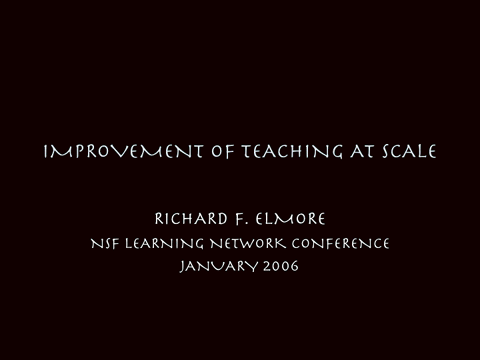
I wanted to say that since a lot of what I have to say to you this morning is challenging that the main reason I'm here, and the main reason I do my best to accept any invitation that involves the work that NSF does in this field is that I regard this work as the most important work that's going on currently in the improvement of instructional practice. I view it as-- and you'll see later-- a sort of massive project in the development of the intellectual capital necessary to make the kinds of instructional improvement and the kinds of improvements in learning that are going to be necessary.
But intellectual capital has two dimensions. One is the ideas in play and the practices that go with them. Secondly, intellectual capital is a form of social capital, which means that it is in part the networks of individuals and the institutions that aggregate around those people, and the commitments that those institutions make to act in concert with each other, which I think is one of the things that's impressive and important about this work.
Secondly, I wanted to say that that the part of the quality issue that I'm going to address-- you're going to hear from Richard Ingersoll, who has literally written the book on teacher quality as defined by the processes by which we produce, employ and retain teachers. The angle on teacher quality that I'm addressing really has to do with creating and sustaining high quality practice in the work place. Because a part of me that is very concerned about the underinvestment in knowledge and skill among people in the current education labor force-- I've written about this in other settings-- do you have a connection here? I can accommodate that.
Also, I'm deeply influenced by the work of labor economists who work in this field, not just in education, but in other parts of society. And I'd just like to say that at the outset, you'll hear it at various points in what I have to say as the morning goes on, that I think that there are some disadvantages to thinking about teacher quality as some sort of stable set of attributes that teachers bring to their work. Increasingly, what's happening to the education sector is what's happening to the rest of society, which is the world is going flat. The knowledge and skill requirements of working this sector are not only accelerating, they're changing, and they're changing at an increasing rate.
The idea that the same set of attributes, in particular, would be equally important 10 years from now as they are right now, I think, seems absurd to me. And we have a culture in schools that promotes this idea, and the mindset of policymakers promotes this idea. It's hard to reinforce by social scientists and by conventional wisdom. There is this fixed set of attributes out there that if you select for them, and you put people in the right positions, and you turn them on and set them loose, then you've solved the problem of quality in American education. That's going to take us straight to the bottom.
The vision has to be that the attributes that are required for entry are those-- are best guesses about what qualifies people for the work. The attributes that are most increasingly going to be most predictive of people's success are their capacity to assimilate new ideas and change over time, and to operate in concert with each other, to form communities of practice, to operate in powerful ways in concert, to acknowledge that people have to work in organizations to get this work done; working in organizations in powerful ways requires that people learn about organizations and how they work, and assimilate ideas, norms and values that have been traditionally associated with the management side of the enterprise.
What do I do? Most of you who probably haven't run into me, I am involved in something called the Public Education Leadership Project, which is a joint project with the Harvard Business School. And over the past four years, we've been working with the senior administrators and nine large school systems in the country to develop an approach to strategy and organization and management in large systems that's compatible with high quality instruction in the classroom. This is a little bit like making the elephant dance. Who was it who said, educational administration is to administration as military music is to music. (Laughter)
The districts include San Diego, San Francisco, Chicago, Boston-- there are nine altogether. In addition to that, I co-chair an organization called the Connecticut Superintendent's Network, which started out with 12 districts in Connecticut. We recently just this fall doubled it to 24. The purpose of that project is to develop a model of the superintendent's seat which is based on the medical rounds model, which is designed to focus the development of skill and knowledge on the part of experienced superintendents to design, run, manage their organizations in ways that are consistent with the promotion of high quality and structural practice in classrooms. I'm beginning to see a theme here.
This fall, I started a similar project with principals in Cambridge, Massachusetts. These projects are designed to develop literally a model of practice. That is my basic point of departure is that education is a profession without a practice. That in our society, professions have status, impact and leverage in the world at large to the degree that they claim expertise, and use it for political purposes. I'm a political scientist, or a recovering political scientist by training.
Teachers have practices. Administrators have practices. Some superintendents even have practices. Education does not have a practice. It does not therefore have a body of knowledge it can use to exclude people, to identify itself as a power broker in the development and dissemination of knowledge, and to use as a basis for making organizational and financial choices. Therefore, being involved in the improvement of instruction on a large scale in school systems, as I have been for the last 10 years or so, is often sometimes a little like just being in a lottery. Sometimes you hit and sometimes you don't. The organization is not designed to do what it's supposed to do, because it doesn't have a practice that goes with its central purpose.
So, my feeling about this enterprise is that you need to begin to develop, just at the molecular level, a set of protocols, a set of conventions, norms, a language, a set of ideas about how practices look, what they feel like, what mutually enforceable norms look like when they're actually in play, what it looks like when people call each other for behavior that's inconsistent with those norms, and the discipline that's required to relate those norms to some sort of evidence of their impact on teaching and learning. And that's what we're involved in.
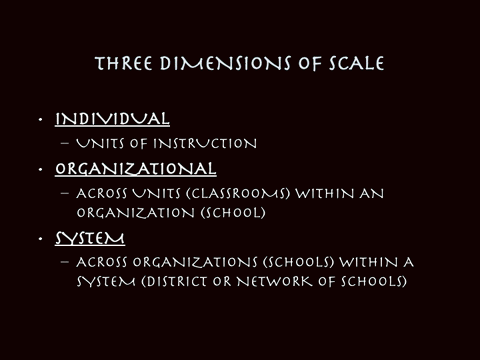
With that as a kind of point of departure, I want now to talk a little bit about the problem of improvement, the problem with teacher quality, and the problem of scale. There are three dimensions to the problem of scale. I think most people think of scale as a kind of mysterious quality. It's either a skin disease or a kind of miracle that happens when the right idea lands in the right place at the right time. Nothing happens by accident, especially in educational institutions which have a strong resilient and intransigent default culture. Nothing happens by accident.
Instructional practices change not because people think that the ideas are good, that they're good for kids or that they're going to prove to be effective over time. Practices in education change because someone has figured out how to displace the default culture with another culture. People don't adopt good practices because they're good ideas and because they work. They adopt them because they've discovered that if they don't adopt them, they can't function in the organization.
So let's issue about the issue of scale on three dimensions. On the first dimension, it's at the individual level. I'd like you to just think about scale as what the student confronts over the course of a week, over the course of a month, over the course of a school year from a single, individual teacher. Now, it's easy for us to think of the perfect lesson as the exemplar of the kind of work that we're trying to do, where everything comes together, the knowledge base, the practice, the professional development, the organizational support; all of it happens in one classroom at one moment in time, on one day when the sun is shining and the birds are singing outside.
What students experience is not that. What students experience is the routine qualities of instructional practice. What students experience is the everyday-ness of it. And unless you're in classrooms persistently and consistently over time watching how teachers deal with these ideas, you don't have a good idea of what the scale or the reach of attempts to change instructional at the individual level are.
Delivering a lesson that's tailored to a new way to think about math or science in a powerful way is a think of beauty and an enormously inspiring event; and I have seen such events in my classroom observations. I'm in about 30 classrooms a month now, in various systems, and I have seen such elements. I have also seen from the same teacher on an adjoining day and in the adjoining classroom dreadful teaching. The student's experience of improvements in curriculum and instructional practice is not the former; it's the latter. But the experience is a series of beautiful events punctuated by long periods of excruciating boredom.
You should also think about scale as an organizational problem. That's across or across classrooms within an organization you might call school. So what does it look like to be a mathematics student in the fourth grade at the Edward Devotion School in Brookline, Massachusetts, which is where my 12-year old twins are currently in the seventh grade. That requires us to have a theory about the interaction of content and pedagogy with an organizational unit called a classroom and probably with a grade level at the elementary level, and with a departmental structure at the high school level.
Scale in this setting means when we travel from classroom to classroom on a given day, at a given time, we expect to see something consistent happening, where consistency can be measured not against program behaviors, but against the type of discourse you want going on, the level of challenge and the questions, the sophistication content, just something as simple as the kind of content that's being covered. Are they learning the same thing at this time of the year in the fifth grade that they learned in the fourth grade?
I would add, I just acquired a-- I have two adult sons. I just acquired a family of four teenagers. One of the remarkable things about-- this is a gift from the gods for an educational researcher. (Laughter) One of the remarkable things about this experiment is the incredible repetitiveness of curriculum and teaching in the American contest. I would say more frequently than monthly, I would say bi-weekly, every single one of these children reports that they are reading a book, studying an issue, reforming some sort of procedure, or dealing with a fact set that they have dealt with at least once before, and as many as three or four times before.
If you've read international comparisons, this is the disease of the American curriculum structure. If you combine that with the amount of time it takes the typical American teacher to get instruction going in a classroom, which is typically about 30% time available for instruction. You've got an enormous tax on the actual content that students are getting. They're getting something like, on a good day with the wind behind you, you're getting something like leverage over about 30% of the resources that are available for instruction.
So scale at the organization level means, are people working in concert around a set of ideas about what curriculum and pedagogy should look like, and is it obvious in their practice. At the system level, it's basically the same question across schools, which is if you look at schools, do you see similarities in what schools are doing, and do you see similar patterns.

Now, to produce large effective scale, you have to manage the processes of improvement at all three levels simultaneously. And that is what, up to this point, has really baffled educational administrators. They have not had a way of thinking about their practice, which allows them to think about the classroom as the unit of analysis, embedded in a system of relationships called a school, which is in turn is embedded in a system of relationships called assistant; and what are the vertical and horizontal processes that are necessary to make this system look like its relatively coherent.
But at each level, the problems are somewhat different. And I don't have time to give you my school improvement tap dance, but I just want to show you one graphic I use when I address this.
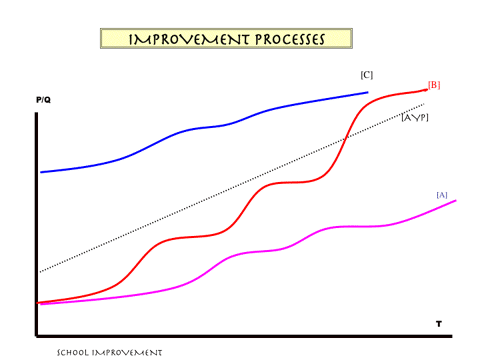
In the Elmore version, improvement is a really simple, some would say bone-headed idea. It's time on the horizontal. It's performance and quality on the vertical. And improvement is making the herd go roughly northeast. These are three actual schools. There are just two things I want you to notice about these improvement paths. One is the slope on average. School aid, I'll talk a little bit about in a moment, but school aid is a school that as adopted a nationally validated curriculum, a brand name curriculum, sponsored by an institution not too far from this very location.
It receives the sort of median or slightly below median version of the professional development package that goes with that curriculum. Teachers in school, they think they're working quite hard. School C, and I can say this because I'm just slightly outside of the zone of intelligence that surrounds the White House. School C is suburban school, which reminds me of what all Ollie ...(inaudible) once said about George W. Bush, born on third base and thought he hit a triple. (Laughter)
School A thinks it's working extremely hard also. Actually, what School C is producing, it's producing largely-- there's a consequence of social capital. It turns out that the main form of social capital that School C is relying on at this particular moment is externally delivered tutors, which the school actually have no idea what the tutors do. They're paid for by parents. And they're funneled in that direction by teachers who have decided that whatever problems the students are presenting can't be dealt in their classrooms, so somebody outside the school must be responsible for it.
School B is the interesting school. School B-- you noticed that the dotted line is AYP. School B could actually, depending on what the time, the horizontal time function is here could actually be out of business at various points on this improvement curve. But it has the steepest improvement pattern.
And I just wrote an op-ed piece for the Harvard Ed. Letter that says this, if you want to study practices of improvement, if you want to know how schools improve, go to school B. Don't go to School A or School C. School A is where it is because it made a conscious, strategic choice to choose a curriculum that was consistent with the existing knowledge and skill level of its teachers, which was low. So it got a low level grade. And quite predictably, a low level curriculum, coupled with low level practice, produces relatively low level results. It also produces a slight improvement.
School C has hardly altered anything except the division of responsibilities between the schools and the community, and so far it's gotten away from that. School B is the only school that's actually working on all three levels of this problem of scale.
Also notice the weightiness of these lines. At any given point and time-- this is a white knuckle operation. For those of you who have worked the schools persistently over time, you know that at any given year, you may be on a plateau, and that plateau may be explained by a lot of things, which is not easy to understand. And where you are on the improvement curve has a profound effect on the sense of efficacy and morale in the organization.

Let's talk now about levels. But before I say that, I just want to say that most of our investments in curriculum and professional development are currently just being lost because they are not being actively managed.

And I think School B is an example of a setting which they are being actively managed. At the individual level, the key determinant of scale is the distance between an existing new knowledge and cognitive-- existing and new knowledge and cognitive complexity. That is where is the work that we're asking teachers to do in relation to what their comfortable doing and what they're currently doing.
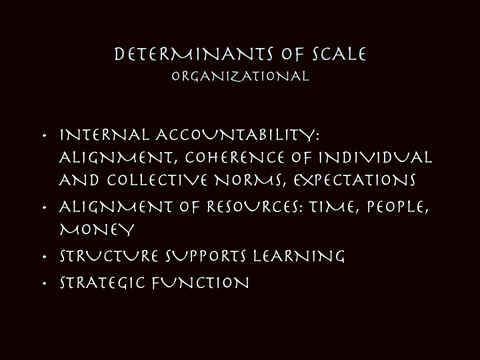
What's the level of individual agency that teachers experience over their own practice and over the performance of students. Typically, teachers start this process with very low agency. That is if you ask them what explains student learning and student performance, they'll give you a long list. The quality of teaching is either not on the list at all, or is very low on the list. Most of the factors had to do with the external circumstances of students. That's low agency. High agency is where teachers put the quality of teaching and instructional practice at the top of the list, and external factors and students lives at the bottom of the list.
What are the conditions within which teachers are expected to learn now practice? And I think, most importantly, what we're learning through the work in the networks is, what are the opportunities for repeated practice? We're seeing an awful lot of teachers getting a sort of dim sum introduction to high level instructional practice, which is you get a taste of a lesson; maybe you get a little bit of professional development around it; you go into a classroom; you do it. Like most of us, if you get about 30% of it going in the right direction at the right time, you feel good the first time you do it, and then the lesson disappears for a year, puff, gone.
The next time it comes around, you have a vague memory of the cold sweat you broke out in the night before. You have a vague memory of some of the strategies you used to confront that cold sweat. You have a vague memory of some of the resolutions you've made and for the ways you were going to try to fix what didn't work the last time. But it's awfully dim. And so what I'm seeing in classrooms is that teachers don't have opportunities for repeated practice of the same work in proximity to their own use of the knowledge. I don't classify different content in the same subject matter using a similar pedagogical strategy as a repeat practice. It's a different problem you're asking teachers to solve. Repeated practice is, in the Japanese context, doing the same thing or watching someone else do the same thing and talking about it that you are actually being asked to do.
At the organizational level, achieve determinant of scale is what I call internal accountability. This is in my book. I should have pictures that I can flash on the screen subliminally. Or maybe I do. (Laughter) But the working definition of internal accountability is the alignment and coherence of individual and collective norms and expectations. The way we did this in our initial accountability study was we went in; we observed a lesson. We observed the teacher teach. Then we did a host interview, and the first question we asked was, how did you decide to teach what you just taught? You would be astonished at the range of answers we got to that question.
Then we asked people what they thought the collective goals of the organization were, and we asked them across teachers and administrators. We got a composite of the collective goals; we got a composite of the way individual teachers describe their decisions about what they decided to teach; and we put the two together. Imagine a Venn diagram, where those two explanations overlapped considerably; you got a high level of coherence. The modal case, however, was that the individual teachers' explanations had very little to do with the story that the organization itself was telling about its collective practice, and that's misalignment and incoherence.
Well, it shouldn't be surprising that you get scale of practice, norms, expectations about what students should learn, it's the similarities and instructional practice, and you get relatively high levels of consistency and practice in organizations that have high levels of alignment. Now, the second stage you also get them where resources are aligned. One of the biggest tasks we have with administrators is-- and this I think is a consequence of really pathological culture over the last hundred years in public schools, is that educators in general, but administrators in particular, think that resources kind of fall out of the sky, and then they go away. And then you have to go get more resources to fall out of the sky so that those can go away.
The actual process of actively managing the flow of those resources through the system so that you say, of our current operating budget, how much is discretionary, and if we say it's discretionary, and we say that we're trying to improve instructional practice in mathematics and science, how much of that money is going toward the improvement of instructional practice in mathematics and science, and how is it being spent? Now, those questions may sound obvious, but those are not questions that are being asked routinely in superintendents' offices and in principals' offices. And it's the lack of that alignment that creates-- that limits scale.
Schools also need to start to think instrumentally about structure. That is how do you use common planning time? How do you use the substitute budget? How do you use all the instructional resources that are available in the school that inherent in the structure of the school and in the school system to support the instructional mission? And the way that these ideas all come together into the management of schools and school systems, we call this strategic function. And this is what we're trying to teach administrators how to do in this project with the business school, which is to imagine a world in which the claims you make about what you're trying to do to improve the learning of students are actually represented in the way you spend money and in the way you design the organization.
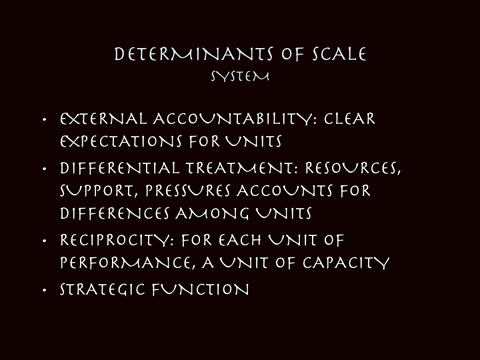
Just as a footnote-- my students call me Dr. Doom. This is the upbeat version of-- (Laughter) The amount of leverage you get with external resources, including NSF funding, directly proportional to the level of coherence in the organization. The rich get richer. ...(inaudible) accountability, which is clear expectations for units and just methods and mechanisms whereby people account for what they do. We're also discovering that success and getting to scale with powerful instructional practices requires a theory of differential treatment. Not all schools present the same problems. Not all teachers within schools present the same problems. You have to find a way of bundling resources, support and pressure that accounts for the differences involved in the schools. We think we have a way of capturing that, but it's important to do it.
Systems that have made progress or the issue of scale also honor what I call the principle of reciprocity, which is for every unit of performance I demand of you, I have a reciprocal responsibility to provide you with the unit of capacity.
This needless to say, makes superintendents and principles extremely nervous. It makes presidents and committee chairs even more nervous. Because what it does it forces people to acknowledge the level of underinvestment that we've made in the development of capacity to do the work that they're being asked to do. I personally subscribe to the work of Karen Miles, who has done a lot of work on resource allocation in school systems, that there are very, very few school systems, urban systems included, where substantial improvements in the level of expenditure on professional development, for example, couldn't be realized within the existing budget.
And more pessimistically, the likelihood that you're going to get value added from additional investments in professional development until you've solved the problem of reallocation in the base budget, is pretty remote. That is the marginal dollar invested in professional development in a system that doesn't have control yet over its own resources and investments in professional development isn't going to have the same effect as it has in a system in which it does have control over those things, and the same for schools.
And finally, at the system level, it's important for senior administrators and for people in the system to share this notion that there is a strategic function, that the system has to be moving; it has to be moving in a direction that everybody understands; and that moving in that direction has consequences for the work lives of everybody in the organization. You can't go into your classroom and shut the door and expect the world to function without regard to you.
One of the interesting things about my work, first of all, I get be in a lot of schools and in a lot of classrooms. I get to watch a lot of teachers teach. I get to look at lot curriculum materials. I get to look at a lot of student work. I get to have very, very interesting conversations with students about the kind of work they are doing. And I get to talk to people at the strategic level about how their decisions affect that. It occurred to me as I was thinking about-- I know that you too are very active in schools and classrooms, that you're committed to improving practice, and that you spend a lot of time with teachers and administrators. I think we have that in common.
I also feel however-- and I know this-- I've learned this the hard way--that I see a lot of classrooms after you're gone. I see a lot of classrooms after teachers have had the professional development that you have provided. I see a lot of schools that have made a commitment to your project, and then I see the consequences of it in the daily-ness of instructional practice, rather than in the classrooms where you think you're doing your best work. And I'm trying to avoid the Dr. Doom scenario. I just want to say there is much, much opportunity for improvement here.
So a few observations about the design of professional development and how it fits into this issue of scale. I have a strong, strong bias, and I'm going to put it on the table.
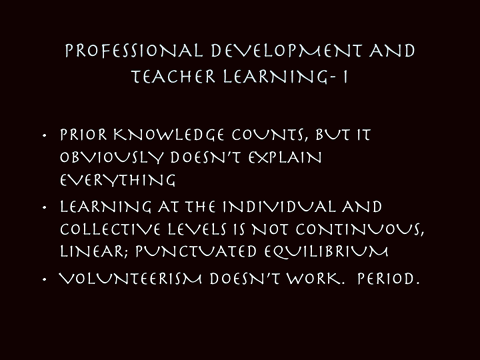
Prior knowledge counts, that is what teachers know about the content and what they know about the pedagogy does count. But it obviously doesn't explain everything; and this is the most moderate way, I could figure to phrase this. The way I started out phrasing it was prior knowledge counts, but not remotely as much as you think it does.
I recently observed a lesson, a fifth grade math lesson in a school in a district which has adopted a brand name, high level, mathematics curriculum, a curriculum that I think is, personally, as a parent, as a professional, the gold standard for mathematics instruction. This was one of the most puzzling observations that I think I've ever done. In the process of the observation, the teacher demonstrated the level of fluency with mathematical ideas that were imbedded in the curriculum unit that I thought was extraordinary.
She manifested a knowledge of pedagogy and the activity design that was embedded in the curriculum that was the worst I've ever seen. What came out was the most unbelievably bastardized version of a beautifully designed curriculum that I have ever seen. Now, this is not a consequence notice of the teacher's mathematical knowledge. I'd be wiling to give this teacher a test right now. It's a consequence-- and I think that she fills that she's a very experienced teacher. She feels that she has a pedagogy that matches this content. It just happens not to be the pedagogy that's imbedded in the curriculum. The consequence was the most amazingly incoherent dog's breakfast of mathematical ideas and haphazard student engagement, and unbelievably common and un-capitalized on misconceptions, including teachers misconception about student learning that I've ever seen.
Now, what do we do with a case like that? And I want to say to you that cases like that are lot more common than you think they are. That is you might want to just creep into a classroom occasionally of the teachers who you think are your extemporary teachers, the teachers who tell you that the curriculum is the best thing since sliced bread. Just kind of slide into the classroom sometime and just take a peak at what exactly happens when you're not there or when you're not working in some structured or supervised professional development environment.
Now, this teacher has a lot of work to do, and the kids are paying a very high price. And we a kind of just in time problem here; and in fact, this observation was part of a visit in a principals' network where we were actually working on the problem of the fact that the curriculum was nominally in place and the math scores didn't show it.
So, I think it is important to value prior knowledge in the construction of professional development. It is also important when you're doing that to acknowledge up front that you're asking teachers to do things that they do not know how to do. And that while you're validating prior knowledge, you have to be very tough on what the actual practice looks like that goes with the knowledge they have, that it's not just the deployment of existing knowledge. They have to learn to think about instruction in radically different ways. And this, as I say, this problem is more common than I had expected.
We also see the other problem a lot where teachers-- really, the only they're going to learn the math is by teaching it. These high level curricula I have come to believe are powerful instruments for carrying mathematical knowledge to teachers. But if it's going to happen, somebody has to literally do it; and it has to be done in a setting where teachers have repeated opportunities to practice, to be observed and to use their practice as a way of understanding the basic ideas.
As you saw from the weightiness in those curves, learning at the individual and collective level is not a continuous process; it's wavy. It's periods of growth followed by periods of consolidation, stability and decline; followed by periods of growth; followed by periods of stability, consolidation and decline. People actually will appear to get worse at something you thought they knew how to do, before they get better at it again. And they'll do it in the context of much more powerful ideas about the work. This is, it turns out, a very common pattern of all processes of human development, individual and collective. It's the well known punctuated equilibrium model. Things stabilized for a while before they shift dramatically.
I also what to say to you, if there's one part of the prevailing default culture that you can work on, it's the volunteerism things. I personally would never enter a school now where the principal said to me, I want you to work with volunteer teachers. I think the likelihood that you're going to get any kind of scale in improvement by accepting that norm going in is practically zero, because all you're doing is reinforcing the default culture. Volunteerism doesn't work, period.
Now, it is okay to say we're going to start with a norm that everybody is going to do it; and we can't put all of our resources in everybody across the board at the moment. So we're going to phase the introduction of this. But you have to be clear at the beginning, if you accept the norm of volunteerism, what you get is a reversion to the old hundred year problem, which is you're reinforcing the variability of instructional practice in a setting where the whole process has to get people to the point where they can kind of accept norms of consistency and alignment.
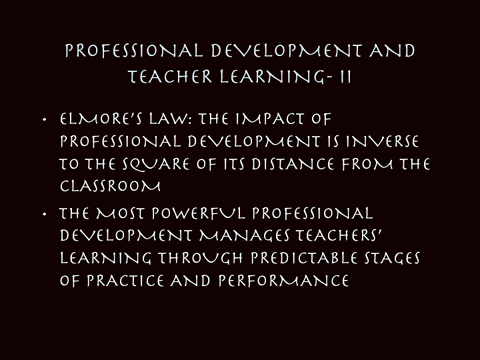
Elmore has three laws; this is the third law. The impact of professional development is inverse to the square of its distance from the classroom. (Laughter) One of the practices that's most consistent undermining the impact of brand name math and science initiatives in schools is the idea of offsite professional development. Now, there are many functions for offsite professional development, and I don't want to discredit it as an idea. I think it can be actually quite powerful in doing certain things, in introducing people to the content, getting them oriented to the curriculum; giving them a little opportunity to practice with their peers; to get a sense of what the pedagogy that goes with the curriculum looks like; and all those things are good. But past a certain point, it becomes spray and pray. It's just a carwash version of professional development.
What happens is I have teachers walk straight up to me in the process of observations and saying, I feel pretty comfortable with this curriculum; I've been professionally developed. (Laughter) That is professional development is an event. It's happened. It's over with. And now I'm free of it. I think the most powerful professional development uses multiple modes, including technology. It has a model that says we're managing teachers through a process of development. That's why I get a little scared when people make attribute definitions of quality as a good teacher because she has the following attributes. All that gives you is the predicted power to put her in a space. What's actually going to determine how good she is at teaching a particular math or science curriculum is whether she has had the opportunity to go through the stages of development that are required to master it. Those might be short and powerful and positive for some teachers, and they might be long and arduous for others.
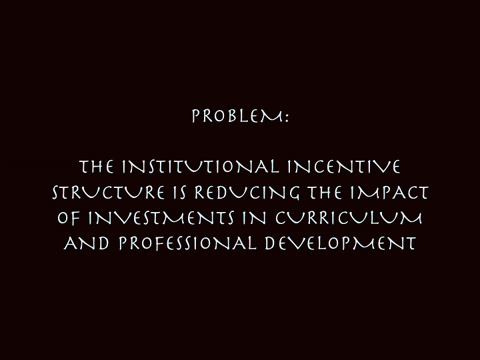
Here is the problem I want to present you with or leave you with. The institutional incentive structure within which we're working here is dramatically reducing the impact of the investments we're making in the development of curriculum and professional development. My biggest problem with superintendents is to convince them that they have to be much pickier, much more intrusive, and much more demanding consumers of curriculum and professional development. They actually have to work hard at negotiating tougher contracts with the people who do professional development and curriculum work in their systems; and they actually have to have in their own mind a theory of improvement that tracks with the theory that the developer is using also. There has to be some agreement on that.
It's partly a problem of under-investing. I want to say that I think we're probably now spending less than a quarter of what we should be spending on professional development in the enterprise in general. But I also don't think that the marginal dollar is going to make much difference unless we get control of the sets of relationships that operate around curriculum instruction, so that we make professional development and make those relationships more powerful. That means that you are actually going to have to become-- I'll just guess-- considerably more knowledgeable about management and organization issues, considerably more knowledgeable about understanding what the problems of improvement at scale are within the organizations in which you're working to develop and adapt the strategy that speaks more powerfully to the actual needs of the individuals and the organizations with whom you're working.
Time after time after time after time, I see superintendents and boards of education that are spending large amounts of money on what I regard as the right curricula and getting really weak results. That's a failure of the internal system of the organization. It's a failure to work out the systemic relationships. But it's also a failure of the party's-- to the development--he curriculum and to the professional development to work out an arrangement which strengthens their role in producing powerful instruction at scale.
I don't see any solution to this except that people on both sides of the transaction need to be much more knowledgeable about the work and about how it plays out in an organizational context.
I'll stop. As I said at the beginning, it's for me an incredible privilege to be in your company to talk to you about these issues, because I think you're doing the most important work, even though I like my literacy friends too. And keep doing it; and join us in an enterprise that tries to do it more powerfully. Thank you very much.